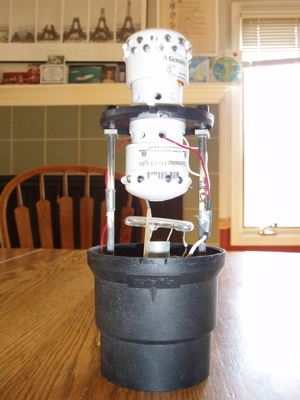
In the quest for energy, here's how we see the standard anchor light: 1A for 12 hours is 12AH which is worth 6 gallons of water per day. Clearly unacceptable! I modified the anchor light using LED lights from http://www.bebi-electronics.com/. Before you write these guys off, they produce a better product at a lower cost than the mongo corporations like Perko, Hella, etc. In doing the modification I soldered all the connections, given that these guys never burn out and need replacing, to avoid another reason to go up the mast. As an aside, and on going up, I love the ATN mast climber. Since I usually work alone and, when I'm not, seem to always fall victim to an override whilst aloft, its a great product: just be prepared for a workout. I did leave the strobe in place, though it is illegal to use.
| Refit |
|
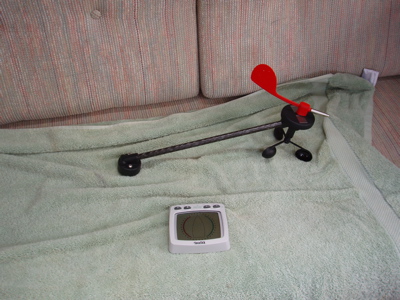
In terms of instrumentation, we converted the boat from Raymarine (yeach, as a company to deal with) and SeaTalk to TackTick and NMEA. Sure pulled out a lot of wire! Cut our power consumption (TackTicks are all solar except the hull transmitter and NMEA interface) and its great to be able to grab and roam with the displays. I like to take one up with me to anchor so I can watch the depth and also down to the nav station for plotting positions and doing log entries: very cool. The only negative is that the LCD displays are not quite as readable as the mechanical displays (wind angle, etc.) We also had the system go bonkers after a near/really close/direct lightening hit during a squall. A reboot got everyone talking again.
| Refit |
|
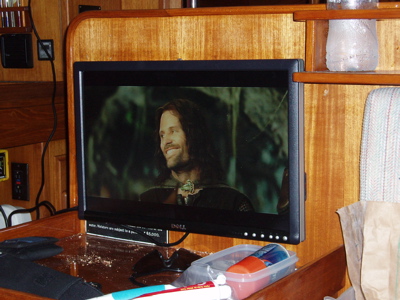
As I mentioned ealier, we're big movie fans. This is a used Dell monitor (didn't want to spend much money for any electronics living under a hatch:) being fed with composite video from the Jensen DVD player. Not home theatre, but very nice for the situation!
| Refit |
|
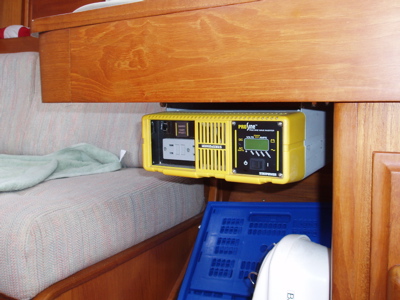
I could never live without this one, from charging/running power tools to running the blender its a winner. I did, choose, however to not wire it into the boat's 120VAC. If I did so, someone might accidentally flip the water heater or battery charger (wired into 120) and deplete the batteries in no time. I think the ultimate answer is separate 120VAC circuits for shore power and invertor power, but I'm not up for that project this time around.
| Refit |
|
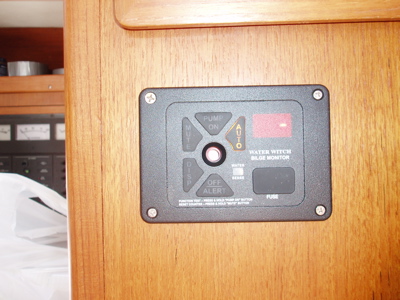
Several times during the shakedowns, the bilge pump went off but, because of the heel, just ran, and ran, and ran... Eventually someone would probably hear it, but it seemed like we needed some sort of alarm to keep us from draining the battery and burning out the pump. There was also a bit of an issue the way the pump was originally wired. In the end I chose a Water Witch monitor/controller together with Water Witch sensors. Very nice components. It alarms if the pump runs continuously or if water get's up the the high water mark. When I'm gone a month, it is comforting to come back and see that the pump did not run (counter). Also frees up another breaker on the panel: precious space.
On that note, I also wanted a dry bilge (yeah right.) The first problem was the thru-hull for the speedo. It was backed with a rotten, stinkin', plywood block. To digress a bit further, the surveyor (Brian Stetler) caught this, and just about everything else that was to fail, during the prebuy: get one and listen. I removed the block and built up a fiberglass backing plate. No more leak. (Also used a trisensor for depth, speed, and temp.) Also replaced the stuffing box with a PYI dripless. Now we're down to diesel leaks. The engine itself leaks a bit, but most was coming from a electric pump installed to facilitate bleeding. Nixed the pump, replaced the filter assembly with one with a built-in bleed pump and moved it up next to the engine: no more diesel leak and no problem bleeding. I still get some water in from the mast (rain) and through the windlass and chain pipe on the bow - workin' on it.
| Refit |
|
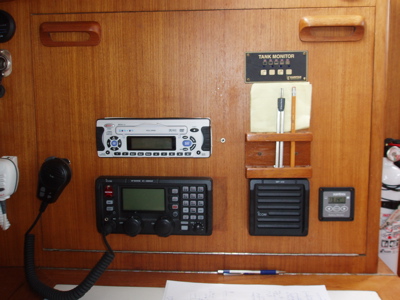
In trying the alternative energy thing, it became quickly apparent that we need means of monitoring energy usage. Because we use a watermaker, fresh water becomes a form of energy. Thus, we found that we need to closely monitor energy in the form of electricity (Xantrex XBM batter monitor) and water (Raritan tank monitor). The XBM is an "always on" device and uses no energy to speak off. The tank monitor uses half an Amp or so, a lot for us, so we hooked it up to the fresh water pump circuit rather than leaving it always on.
We also added a Icom 802 SSB, mainly for receiving weather. Starting with the simpliest first, we are using debonded rails for an antipoise. Worked fine in the Bahamas, but I suspect the antipoise/ground plane may be a work in progress. We decided against added an email modem given that sat technology should overtake SSB shortly.
Last on this panel is the Jensen radio/CD/DVD player. Music is a big part of lives (voice, piano, etc.). As a family, one of our favorite things to do is watch movies together. We used to use a laptop and USB speakers, but now its all built-in. You can see the speakers and screen elsewhere. Not home theatre, but cool by us! (Popcorn pops pretty well in the pressure cooker...)
| Refit |
|
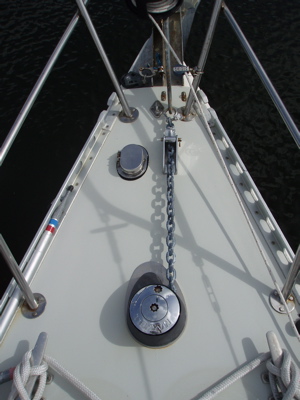
Cute little back saver isn't it? The Maxwell 800 is a low profile, relatively light weight (30 lbs.) windlass that seem very well built and fits the J/40 foredeck well with a low, clean profile. This goes with 100 feet of 5/16 high test spliced to 5/8 12 strand. Works extremely well and just the right size for the boat. Of course cutting that big hole in a cored deck was a bit nerve wracking...
This was the first of several thru-deck bolted projects. I used to drill an oversize hole, file the hole, and redrill. This time I used a different technique for hardware loaded in shear. From under the deck I used a 1" Forstner (sp?) bit to drill up to the upper skin, but not through the skin. I then epoxied in a prefabricated 1" fiberglass plug for each hole. Using a jig appropiate to the hardware (windlass, chain stopper, ...) I drilled the mount holes through the upper skin and the plug. My theory is that this method provides better protection for the core and a higher shear strength than the standard technique, though it is a bit more work.
The anchoring platform for the J/40 is , well, not quite what it should be: a bit light for the job. We added a solid bail, larger roller, etc. but to really have a first class platform you would need to build a custom stem fitting/platform. That's too much for us, so we just live with it.
In addition to the Spade, we also carry a stern anchor (Fortress FX-16) in the stern locker (built-in in the J/40), a FX-23 anchor for the bow, and an FX-37 storm anchor. We have two spare rodes, one of which is compatible with the windlass. The main rode is 100' of 5/16 high test spliced to 150' of 8 plait.
The windlass control is a story in itself. I ordered a SoPac unit. (SoPac OEMs for West Marine BTW.) What a piece of junk. Copper conector and untinned wires. We were heading out, so I quickly installed it, but it barely made it through the week. I threw away the original plug and socket and went with a great product from DriPlug (British). Stainless, tough, and waterproof. I also used the two prong version to provide waterproof 12V outlets on the bow and under the main traveler (where you can't kick it in the dark). The spotlight and flourescent deck light have matching plugs. Its great to keep the spotlight plugged in while underway at night and also to be able to use it from the foredeck.
| Refit |
|
Now that you've seen the arch... We instrumented the boat with a battery monitor (described later) to get a handle on the enegery usage. Basically, we were a 160 AH boat and, through various modifications, are now a 120 AH boat. To go further will require installing a new fridge with better insulation: a job for the future. Going purely solar would require 3-4 120W panels. Given we will be in the trade belt, we went with 2 120W panels and a KISS wind generator. Emperically, we seem to break even with good Sun and 10 kts. or grey skies and 14 kts. We try to run the watermaker (about 2 AH per gallon and also described elsewhere) on high energy days when we have an excess. If all else fails, we start IT up...
The killers are the fridge and the fans, while at anchor. Underway the autopilot and chartplotter take their fair share.
| Refit |
|